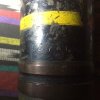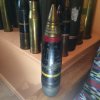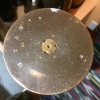British Ordnance Collectors Network
You are using an out of date browser. It may not display this or other websites correctly.
You should upgrade or use an alternative browser.
You should upgrade or use an alternative browser.
Japanese 75mm AAA High Explosvie Round
- Thread starter M8owner
- Start date
I just added this to the Japanese collection. I have seen the fuses and the shell cases before but never a projectile, so I had to have it. It was not inexpensive.
The worst part is that there are four variations of the projectile. Single rotating band, double rotating band, single with a high bourlette band, double with a high band. Collect the entire set. And odds are you need the rest of the fuze. For use with the HE round there is an additional auxiliary piece (away from the library at the moment) that fits below the main fuze body.
And just a friendly reminder, Mr. Bougainville downloaded a ton of WW2 Japanese ordnance books and manuals. Easy access to most everything the Japanese fielded in the last big misunderstanding.
There are a lot of problems with the WWII documents on Japanese ordnance. When working on the weapons in Japan and China we realized very quickly that the US and many of the UK/Commonwealth documents were crap (best of the group being those from Kirkee). Much of it was simply a wartime intell issue that, unlike the European theater, was never corrected after the war. As a result you can look up any number of munitions and find incorrect diagrams, and looking at three different manuals find three different measurements given for a munition. Unfortunately we would compare the three measurements with the actual piece and find that all three did not match the real item. This happened so often that many of the documents were simply considered not accurate enough to use (TM 9-1985 series, etc) For a significant number of pieces we could see an inaccurate diagram in a US book, which then would show up in a later dated UK book, which would then show up in a later dated Australian book.
The second problem was that an incredible number of Japanese munitions are not documented in western manuals, and the majority of the Japanese manuals were destroyed. I have hundreds of photos of Japanese ordnance that we have not been able to ID, with ordnance of every type you can imagine.
Many years ago I started work on an identification manual for Japanese Explosive Ordnance. I was responsible for assisting in the identification of suspected chemical weapons abandoned in China. We would routinely visit recovery sites with hundreds to thousands of recovered pieces (One site estimated to have 1.5 million CW weapons alone). When visiting you would frequently find ordnance that was not in the books, or was incorrectly identified in the manuals. Much of this was a political exercise - China would look at the unidentified piece and say "we suspect CW". Japan would look at the same piece and state "we believe that it is not CW". Then both look at you.
As the military manuals proved unreliable, I started work on the ID handbook. For a number of years I took photos of every item I could find. I had unprecedented access, recovery sites, museums, schools, EOD collections, private collections - Throughout China, Japan, Australia, Europe, the Solomon Islands the US - anywhere I could find a new piece to photograph, live or inert. Once I started running out of actual items, I started looking for historic photos. The best of the US books is the OPNAV book, that was made from a consolidation of two MEIU books. When they made the OPNAV they left a significant number of photos out. I've been through all three of those books and over a hundred others. If it could be salvaged through photoshop I took it. Then came multiple visits of a week or more to the US National Archives. An absolute treasure trove of information. Many of the misc (non-Jap) photos found there have been posted on this forum.
In the end(?) I had a document split into three books, totaling over 1200 pages. Not a lot of detailed information, but much of it was unverifiable anyway. But all photos, my own or historic, color whenever possible. Caliber and length if known, with bits and pieces of whatever reliable information I could find.
My biggest problem was what to do with it. I have thousands of hours of work invested, more than I can ever regain. If you put anything out electronically it is gone immediately, corrupted for whatever use someone will put it to. If I publish and put it into book form, the cost would be prohibitive. One volume at 400 + pages of 90% color, done in any level of quality - $125-250, depending on who you listen to. With three volumes, how many folks can afford or would spend $600? I've spoken with many people that have done books, they tell me that the rule of thumb is that you must charge 5x the cost of printing - if you want to break even.
So I'm sitting on it. US EOD has expressed interest (they purchased a previous book on a different subject that I cannot release publically), if I can sell to them then I consider it out and would probably sell on cd. Until then - info keeps trickling in, I got some new photos just last week of a Japanese chemical submunition that was previously unknown, it is in the file to be added. Eventually I'll do something.........
Slick
Well-Known Member
No doubt, there are errors and misinformation in every manual. One of my chores while wearing stripes was to update, with revisions, our in-house manuals. Besides weapons manuals, each piece of equipment had a manual. A near weekly chore. A new and improved manual would eventually supersede the old outdated copies (with all the revisions I'd spent hours installing) after which they would find themselves in weighted bags for disposal. To deep six. Official procedure. Resulting in a sense of wasted time. Anyway, as "erroneous" and limited as some of the information may be, it does not lessen the value of the info overall. Case in point, the variations, as Jeff noted earlier, of the topical 75MM AA round. Minenaz16, FZG76 and my docs effectively point out the variations. Three different sources, three versions. M8's example appears to be yet another variation. To have the abundance of downloaded manuals gives the opportunity to define the items in question and narrow down specifics, improving the existing data base, such as it is, and provides a resource that is not available anywhere else. Incomplete is lots better than nothing at all.
Agreed, the books are at least as important as the piece, sometimes more so. But I just recently had a sidebar conversation with a member in regard to the reflex action that some have to labeling things as fakes, because it is not in "the book". Books/manuals are made by people, based on the information available to them. They are flawed in that way. There is not an author out there that would like to wait a little longer to publish, because they know that this is incomplete, or needs to be updated, etc. Military manuals are often much worse, because most times the author(s) is not invested in the project, and oftentimes knows nothing about the subject. As an exercise I used to have my guys (EOD) identify errors in the manuals and submit requests for change (DA 2028). After a few weeks they would get a phone call from the manuals folks asking for further clarification, and explaining that they had no training in this subject, they just slap the books together.
This has not changed. We have people on this forum that can explain the difficulties in working with these folks and the errors and gaps known to exist in many of the documents that they have created and we take for granted. But I am with you 100% that we need these books, in most cases they are the best we have. I am just a little more cautionary in looking at any book or group of books as all-encompassing or covering most everything.
This has not changed. We have people on this forum that can explain the difficulties in working with these folks and the errors and gaps known to exist in many of the documents that they have created and we take for granted. But I am with you 100% that we need these books, in most cases they are the best we have. I am just a little more cautionary in looking at any book or group of books as all-encompassing or covering most everything.
BOUGAINVILLE
Well-Known Member
I totally agree about the manuals. I have a fetish for them and can see a lot of omissions, conflicting measurements etc. I always maintain that as US-Subs mentions that the Kirkee manuals are the cream of the pick. When the British do something they do it well. Must be from their Teutonic heritage:tinysmile_shy_t:.
I can never get enough manuals and find that even though a lot of the information will be duplicated, that I always will find new information that doesn't appear elsewhere.
Couldn't do without the manuals as reference and resource material but at the same time I know that they have their shortfall. I envy the ordnance/militaria enthusiasts in Japan as they can read and source information from the original Japanese material that we don't have access to, due to language barriers. A classic example of this is when Olaf through communication with one of the Japanese collectors found out about the meaning and background to the F head stamp.
In the end it makes collecting Japanese more exciting and is like a journey of discovery.
As Rick mentions for those that want to find some good information on Japanese ordnance just look at what I have uploaded in the downloads section. You will also find all of the available Kirkee publications there as well.
I have more manuals which I will be scanning and putting into PDF when I am on 4 weeks holiday. These are Volumes 1 & 2 of Japanese Projectiles put out in April 1945. These are a result of direct translations from wholey Japanese documentation. There is stuff in both these manuals that I haven't seen elsewhere which is exciting. Once finished I will upload the PDF files to BOCN.
Cheers,
Robert
I can never get enough manuals and find that even though a lot of the information will be duplicated, that I always will find new information that doesn't appear elsewhere.
Couldn't do without the manuals as reference and resource material but at the same time I know that they have their shortfall. I envy the ordnance/militaria enthusiasts in Japan as they can read and source information from the original Japanese material that we don't have access to, due to language barriers. A classic example of this is when Olaf through communication with one of the Japanese collectors found out about the meaning and background to the F head stamp.
In the end it makes collecting Japanese more exciting and is like a journey of discovery.
As Rick mentions for those that want to find some good information on Japanese ordnance just look at what I have uploaded in the downloads section. You will also find all of the available Kirkee publications there as well.
I have more manuals which I will be scanning and putting into PDF when I am on 4 weeks holiday. These are Volumes 1 & 2 of Japanese Projectiles put out in April 1945. These are a result of direct translations from wholey Japanese documentation. There is stuff in both these manuals that I haven't seen elsewhere which is exciting. Once finished I will upload the PDF files to BOCN.
Cheers,
Robert
I totally agree about the manuals. I have a fetish for them and can see a lot of omissions, conflicting measurements etc. I always maintain that as US-Subs mentions that the Kirkee manuals are the cream of the pick. When the British do something they do it well. Must be from their Teutonic heritage:tinysmile_shy_t:.
[...]
Cheers,
Robert
As Prussian Field Marshal Von Moltke said:
"You know, the British Army have the best training manuals in the world; it is lucky for us that they don't read them!".
Robert,
You may remember that I copied my collection of Chief Inspector Ammunition (Kirkee) Technical Reports. I have always regarded these as more like 'exploitation' reports and more useful for that. The 'Pink' Leaflets however seemed to meet a less demanding requirement for identification in the field. This thread has reminded me that I have some foolscap (same size as the Technical Reports, 13 x 8 ins) Japanese Ammunition Leaflets which pre-date the pinks and seem to be a half way house between exploitation and identification. I am not sure if you have these uploaded but will check later.
Best,
BOUGAINVILLE
Well-Known Member
As Prussian Field Marshal Von Moltke said:
"You know, the British Army have the best training manuals in the world; it is lucky for us that they don't read them!".
Robert,
You may remember that I copied my collection of Chief Inspector Ammunition (Kirkee) Technical Reports. I have always regarded these as more like 'exploitation' reports and more useful for that. The 'Pink' Leaflets however seemed to meet a less demanding requirement for identification in the field. This thread has reminded me that I have some foolscap (same size as the Technical Reports, 13 x 8 ins) Japanese Ammunition Leaflets which pre-date the pinks and seem to be a half way house between exploitation and identification. I am not sure if you have these uploaded but will check later.
Best,
Hi Norm,
Good hearing from you. Just got back from 4 weeks in Bougainville. Last Saturday I was lucky enough to get down to Buin in the south. Saw some amazing Japanese pill boxes, both concrete and an armoured plated variety that I had never seen before. Will post photos once I get organised.
I certainly haven't seen the foolscap leaflets. Would be interested in seeing them.
Wishing you all a very happy New Year,
Cheers,
Robert











